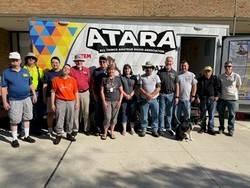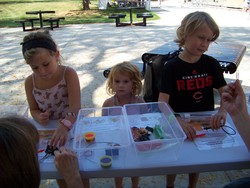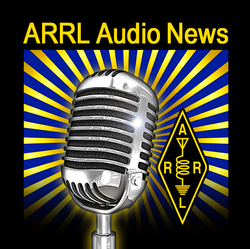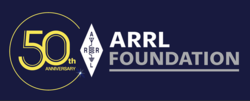 October 5, 2023 John E. Ross, KD8IDJ, Editor
| ||||||
Comment Deadlines Set on Proposed 60 - Meter Band Changes A public period is open until October 30, 2023 for radio amateurs to comment on proposed changes to the 60 Meter band. Currently, radio amateurs in the US have use of five discrete channels on a secondary basis on which they are permitted an effective radiated power (ERP) of 100 watts ERP. In the Notice of Proposed Rule Making the FCC solicits comment on reducing the secondary allocation to 15 kHz of contiguous spectrum between 5351.5 - 5366.5 kHz with a power limit of 15 watts EIRP (equivalent to 9.1 watts ERP). The lesser spectrum and reduced power limit was adopted by the 2015 World Radiocommunication Conference (WRC-15). The federal government is the primary user of the 5 MHz spectrum. The National Telecommunications and Information Administration (NTIA), the federal government's spectrum regulator, has argued that the WRC-15 proposals should be implemented as written. Doing so would result in amateurs losing four of the discrete channels they have been using on a secondary basis and having the maximum permissible power reduced by more than 10 dB, from 100 watts ERP to 9.1 watts ERP. In 2017, ARRL petitioned the FCC to keep four of the current five 60-meter channels -- one would be within the new band -- as well as the current limit of 100 watts ERP. "Such implementation will allow radio amateurs engaged in emergency and disaster relief communications, and especially those between the United States and the Caribbean basin, to more reliably, more flexibly and more capably conduct those communications [and preparedness exercises], before the next hurricane season ... ," ARRL said in its petition. ARRL said that years of amateur radio experience using the five discrete 5-MHz channels demonstrated that amateurs coexist well with the primary users at 5 MHz. "Neither ARRL, nor, apparently, NTIA is aware of a single reported instance of interference to a federal user by a radio amateur operating at 5 MHz to date," ARRL said in its 2017 petition. ARRL will continue to advocate to maintain the 100-watt limit for 60 meters, continued authorization for the four channels outside the WRC allocation that are being used today, and adoption of the new 15 kHz allocation with the same 100-watt power limit. In the NPRM, the FCC recognizes that Canada adopted rules equivalent to those proposed by the ARRL. "Finally, we note that Canada has essentially implemented the same rules as ARRL has requested," the Commission wrote. The FCC seeks comment on the proposed 15 kHz of contiguous spectrum, but also on whether the existing channels should remain allocated to amateur radio on a secondary basis, and whether the maximum power limitations should be reduced from 100 to 9.1 watts ERP. The FCC also requested comments on whether the power limitation should be expressed as EIRP as the WRC-15 recommends or as ERP as in the current rules. ARRL Launches The NTS Letter There's a new newsletter in the ARRL repertoire as of this week. The first issue of The NTS Letter was published on October 3, 2023. The NTS Letter is a monthly digest of all things related to the ARRL National Traffic System®. It is edited by Marcia Forde, KW1U, who is a veteran traffic handler and serves as the Section Traffic Manager for the ARRL Eastern and Western Massachusetts and Rhode Island Sections. The NTS is network that allows for rapid movement of messages, referred to as "traffic," from origin to destination, and for training amateur operators to handle written traffic and to participate in directed nets. The network consists of the layering and sequencing of both voice and CW traffic nets, as well as a digital system that operates 24/7. Director of the ARRL New England Division, Fred Kemmerer, AB1OC, said the NTS is a great way to get involved in emergency communications. "Newly licensed and experienced amateurs alike who participate in NTS find satisfaction and enjoyment in learning the skills of sending and receiving concise written voice and CW traffic in an organized, on-air network. It's a natural complement to the skills and training one needs to become an effective emergency communicator and Amateur Radio Emergency Service® volunteer. Plus, it's an opportunity to meet new friends, and it's fun!" said Kemmerer. The NTS Letter is published monthly and is free of charge to ARRL members. Members can subscribe at arrl.org/opt-in-out by selecting "edit" to view all of their subscription preferences (members need to be logged in to their ARRL website account to do this). WestFest STEM Event Offers Hands-On Experience Amateur radio was represented at the seventh annual WestFest event at The Ohio State University in Columbus, Ohio, on Saturday, September 30, 2023. WestFest is a public engagement event that highlights science, technology, engineering and mathematics (STEM) research, sustainability initiatives, and outreach programs at The Ohio State University. The event featured three behind-the-scenes tours and 39 activity booths. The Amateur Radio and RF Club at The Ohio State University, W8LT,
and the All Things Amateur Radio Association, W8ATR, provided information and hands-on STEM experiences for nearly 400 attendees. The W8ATR Mobile STEM Trailer, funded by a grant from the ARRL Foundation, included a CW oscillator, a display about the history of Morse code, and signage explaining the history of wireless technology and radios. Three Snap Circuits® stations were set up for visitors to build an FM radio, and there was a working replica of a spark-gap transmitter. The trailer also featured a complete amateur
station with a telescoping mast and a quarter-wave vertical ground-plane antenna. "It's important to have amateur radio [be] a part of the STEM experience," said Lawrence L. Feth, PhD, Professor Emeritus and Faculty Advisor to W8LT. ATARA Activities Director Diane Warner, KE8HLD, said throughout the day the STEM trailer hosted 52 adults and 80 children. "Watching the children's faces as they experience the sounds and sights of amateur radio technology is aways rewarding," she said. Additional information about WestFest is available at The Ohio State University website. Amateur Radio in the News ARRL Public Information Officers, Coordinators, and many other member-volunteers help keep amateur radio and ARRL in the news. "Ham radio more than a hobby for Hoosier Energy employees" / Hoosier Energy (Indiana) August 7, 2023 -- Hoosier Energy amateur radio operators. "How to get started with a ham radio license" / Donald W. Reynolds Journalism Institute (Missouri) October 5, 2023 -- Missouri School of Journalism.
ARRL Podcasts On the Air The cover story of On the Air's September/October 2023 issue, "Foxhunting Basics," doesn't have anything to do with chasing down a woodland creature. Foxhunting is a radio direction-finding activity that you can enjoy with a radio club or group, or even with just one other friend -- and they don't even have to be a ham! Rob Zielfelder, N1NUG, explains how to get started with a couple of handheld radios and a directional antenna that you can make from inexpensive hardware store materials. One player hides somewhere with a radio, and sends intermittent transmissions, while the other player tracks them with the help of the radio's signal meter and a map. Listen to this month's episode for more information on how to join the fun. ARRL Audio News The On the Air podcast is available on iTunes (iOS) and Stitcher (Android). The On the Air podcast and ARRL Audio News are also on blubrry -- On the Air | ARRL Audio News. Announcements The Tamiami Amateur Radio Club (TARC) will host Ham Radio Day at the William H. Jervey, Jr., Venice Public Library in Venice, Florida, on October 14, 2023. The event will run from 10:00 AM to 3:00 PM ET, and it will feature special event call sign N4V and two stations on CW and phone. These stations will be set up outside the library entrance to demonstrate ham radio to the general public. A new partnership has been established between TARC and the Sarasota County libraries to make 44 books, including 15 titles on amateur radio, available to any patron of the 10-library system. A grant from the ARRL Foundation was combined with member donations to purchase the books. Promotion for the event began in August with a display case in the library lobby covering ham radio's past and present. "Making these books available to the public is a natural extension of our club's mission to encourage, teach, and assist people to explore a range of interests in ham radio," said Brian Jacobson, W1JBD, TARC project leader. The ARRL Foundation is now accepting grant applications from amateur radio organizations for eligible amateur radio-related projects and initiatives, particularly those focused on educating, licensing, and supporting amateur radio activities. To grow amateur radio's future, youth-based projects and initiatives are especially encouraged. Additional information and a link to the grant application form can be found at http://www.arrl.org/amateur-radio-grants In Brief... Amateur radio clubs and operators across the country are preparing for the ARRL Simulated Emergency Test (SET) on October 7 - 8, 2023. The SET is ARRL's annual national emergency exercise designed to assess the skills and preparedness of Amateur Radio Emergency Service® (ARES®) volunteers, as well as those affiliated with other organizations involved in emergency and disaster responses. The SET is open to all radio amateurs and partner organizations, in addition to national, state, and local officials. To get involved, contact your local ARRL Emergency Coordinator or Net Manager. SET guidelines and report forms can be found at ARRL Simulated Emergency Test (SET) Guidelines+. Ahead of the exercise, the Fort Herkimer Amateur Radio Association(FHARA) recently acquired a 24-foot-long Disaster Action Response Trailer (DART). In conjunction with the Herkimer County Public Health Office, the trailer will be used in emergency situations, public service, and educational opportunities. The DART trailer was recently on display at the Herkimer County Fair in Frankfort, New York, and it was well received by state, local, and county officials. Meanwhile, members of the Calvert Amateur Radio Association (CARA) in Maryland attended a presentation by Ron Startzel, KB5LNC, on the Automatic Packet Reporting System (APRS) to prepare for the ARRL Maryland-DC (MDC) Section SET exercise. Calvert County Emergency Coordinator Shawn Donley, N3AE, recently configured one of CARA's Kenwood TM-V71A radios in Barstow, Maryland, to be an APRS digipeater. Last fall, the site was proven to cover nearly all the county's land area. The APRS presentation helped give CARA members a greater understanding of the system. The presentation will be posted on the club's website for further reference. For more information on APRS, please visit http://www.aprs.org/. The MDC Section's SET will evaluate communications between field teams by locating National Geodetic Survey benchmarks and using APRS data and location services. The local Emergency Coordinator will pass the information to the MDC Section Emergency Coordinator using Winlink or other means. The MDC Section SET is part of ARRL's SET exercise. The K7RA Solar Update Tad Cook, K7RA, of Seattle, Washington, reports for this week's ARRL Propagation Bulletin, ARLP040: Seven new sunspot groups emerged this past week, but overall solar activity has declined. It's great to see the sun covered in sunspots; see Spaceweather.com's recent image of the sun at https://www.spaceweather.com/images2023/04oct23/hmi1898.gif. You can change the /04oct23/ field in the above URL to view a solar image of any date. By loading images of consecutive dates, you can initiate an animation using the back and forward buttons on your browser. We are currently enjoying improved HF propagation with the change of seasons after the autumnal equinox. This is particularly noticeable on 12 and 10 meters. Read an optimistic news story about the current solar cycle at https://cdapress.com/news/2023/oct/02/were-strong-solar-cycle/, and another report at https://bit.ly/3RMPjT1. One new sunspot group appeared on September 30, followed by three
more on October 1, and then one each on October 2, 3, and 4. The average daily sunspot number declined from 170.6 to 128.6, while the average daily solar flux went from 168.8 to 155.6. Geomagnetic indicators were quieter. The average daily planetary A index went from 17 to 9.1, and the average daily middle latitude A index declined from 13.7 to 8.9. The outlook for next month has the solar flux at 160 on October 5; 162 on October 6 - 8; 155 on October 9 - 10; 150 and 160 on October 11 - 12; 158 on October 13 - 14; 156 on October 15 - 17; 154 on October 18 - 20; 152 on October 21; 154 on October 22 - 23; 156 and 158 on October 24 - 25; 160 on October 26 - 28; 162 on October 29 - 31, and 164 on November 1 - 3. If we use this forecast as a guide, we can predict the solar flux average for the next reporting week, October 5 - 11, to be 2.4 points higher than that of this week. Predicted planetary A index is 12 on October 5 - 6; 15, 8, and 5 on October 7 - 9; 8 on October 10 - 11; 5 on October 12 - 21; 10 and 8 on October 22 - 23; 5 on October 24 - 28, and then 15, 12, 8, 15, and 8 on October 29 - November 2. Sunspot numbers for September 28 - October 4, 2023, were 109, 102, 106, 136, 146, 150, and 151, with a mean of 128.6. The 10.7-centimeter flux was 147.8, 155, 159.1, 161.1, 157.4, 153.7, and 155, with a mean of 155.6. Estimated planetary A indices were 6, 12, 10, 9, 9, 8, and 10, with a mean of 9.1. Middle latitude A index was 5, 13, 11, 9, 10, 6, and 8, with a mean of 8.9. A comprehensive K7RA Solar Update is posted Fridays on the ARRL website. For more information concerning radio propagation, visit the ARRL Technical Information Service, read "What the Numbers Mean...," and check out the Propagation Page of Carl Luetzelschwab, K9LA. A propagation bulletin archive is available. For customizable propagation charts, visit the VOACAP Online for Ham Radio website. Share your reports and observations. A weekly, full report is posted on ARRL News. Just Ahead in Radiosport Yearlong -- ARRL Volunteers On the Air (VOTA). See the State Activations Schedule for weekly W1AW Portable Operations, including:
Upcoming Contests:
Visit the ARRL Contest Calendar for more events and information. Upcoming Section, State, and Division Conventions
Search the ARRL Hamfest and Convention Database to find events in your area. Have News for ARRL? Submissions for the ARRL Letter and ARRL News can be sent to news@arrl.org. -- John E. Ross, KD8IDJ, ARRL News Editor
ARRL -- Your One-Stop Resource for
Subscribe to...
Free of charge to ARRL members...
| ||||||

 This nationwide system operates 365 days a year, generally relaying routine message traffic for training purposes and for maintaining readiness if called upon in an emergency. If called upon, these operators stand ready to assist emergency communications personnel and served-agency partners in relaying welfare and other messages. It is the modern continuation of the historic "radio relay" from ARRL's founding in 1914.
This nationwide system operates 365 days a year, generally relaying routine message traffic for training purposes and for maintaining readiness if called upon in an emergency. If called upon, these operators stand ready to assist emergency communications personnel and served-agency partners in relaying welfare and other messages. It is the modern continuation of the historic "radio relay" from ARRL's founding in 1914.

.jpg)
 Listen to
Listen to  The ARRL Foundation grants program accepts proposals on a cyclical basis three times a year: in February, June, and October. Proposals for the June grant period are accepted through October 31. Awardees will be notified approximately 1 month after the closing of each cycle. The ARRL Foundation is also celebrating its 50th anniversary. The Foundation carefully manages a portfolio of endowments where donors have provided specific goals for their gifts, and that portfolio is invested and managed so that it can continue to support those goals for many years to come.
The ARRL Foundation grants program accepts proposals on a cyclical basis three times a year: in February, June, and October. Proposals for the June grant period are accepted through October 31. Awardees will be notified approximately 1 month after the closing of each cycle. The ARRL Foundation is also celebrating its 50th anniversary. The Foundation carefully manages a portfolio of endowments where donors have provided specific goals for their gifts, and that portfolio is invested and managed so that it can continue to support those goals for many years to come. 
.jpg)
-Blue.jpg)








